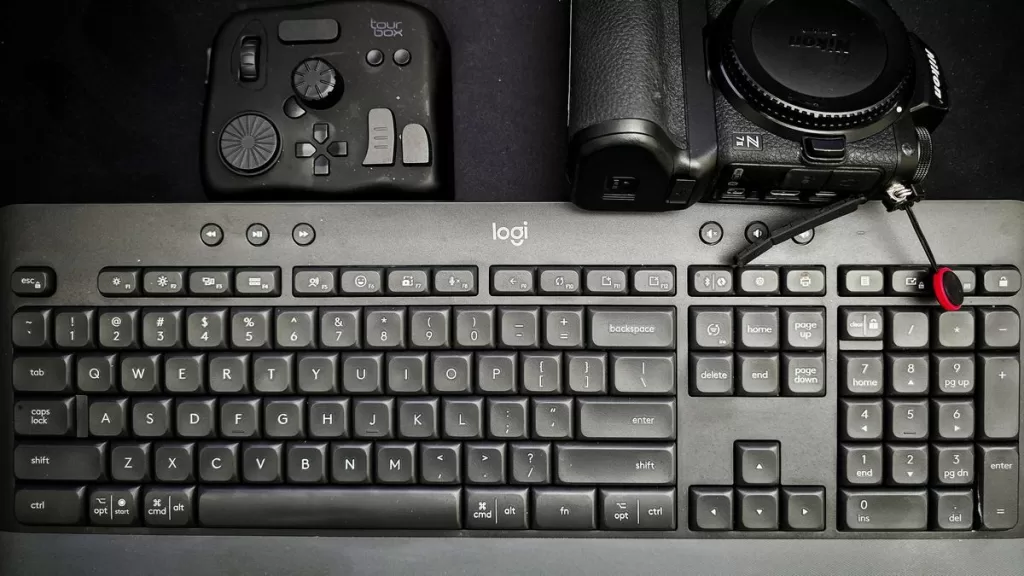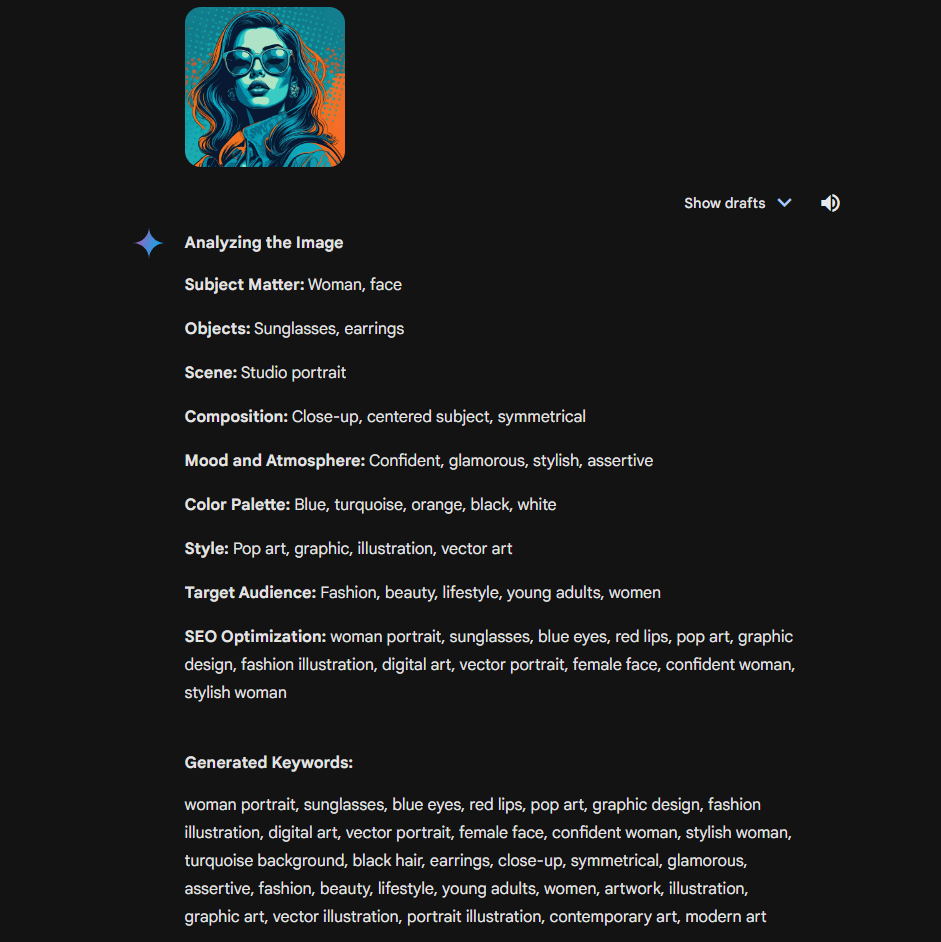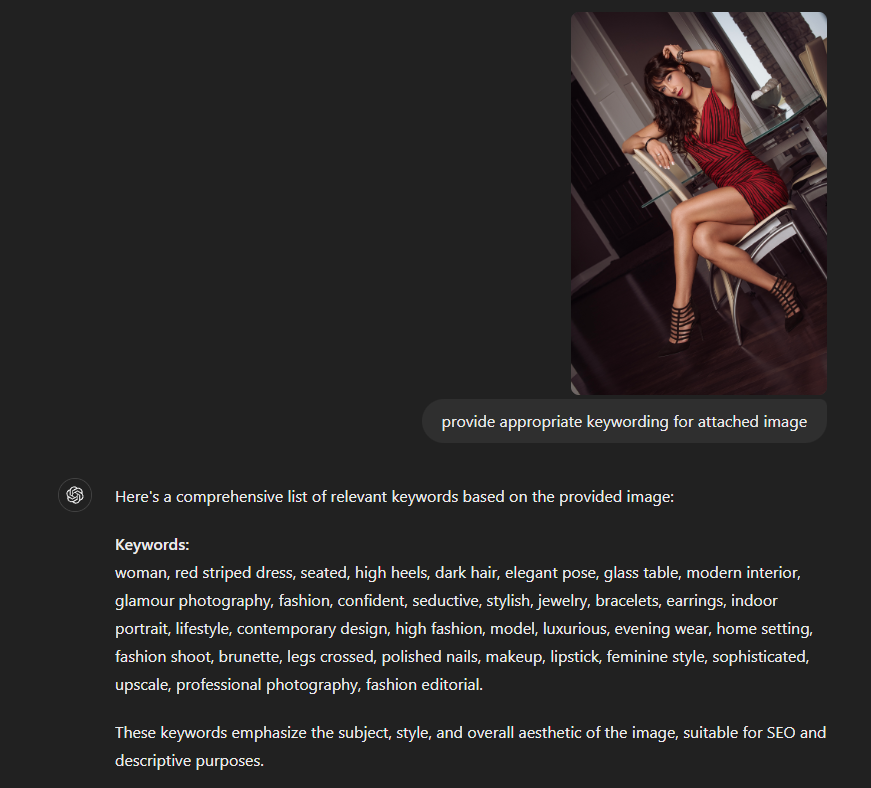Introduction
As a professional photographer, I’ve learned that keywording our image galleries in Digital Asset Management (DAM) software is a critical step that many overlook. Effective keywords are not just about organizing our media library; they’re about enhancing the value we deliver to clients. Proper keywording, alongside meta-tagging, is crucial when posting, sharing, or delivering content to clients.
Let’s face it – generating keywords can be tedious, even mind-numbingly boring. It’s no wonder many of us skip this vital keyword creation process. But here’s where AI comes to the rescue. As part of my workflow, I’ve been developing prompts for Large Language Model (LLM) chat systems to assist with various aspects of my professional work. One of the most valuable is my keywording prompt, which I’m excited to share with you in this blog.
I’ve put this keyword generation prompt through its paces across major AI platforms – Claude 3.5, ChatGPT, Gemini, Perplexity, and Meta AI. While the visual outputs might differ slightly, the keyword generation capabilities are remarkably consistent and reliable across these systems.
Note: Gemini & Meta do not allow for image uploads however you can describe the image and it will render the keyword output for it. Claude 3.5 offers the most comprehensive response.

This guide will walk you through using AI chat service to create comprehensive keyword lists that accurately represent both the content and context of your images. By leveraging these tools, we can transform the often-overlooked task of keywording into a powerful asset for our work.
Whether you’re a seasoned pro or just starting out, mastering this aspect of image optimization through strategic keywords can significantly boost your content’s visibility and value. Let’s dive in and explore how to make AI work for us in creating keyword-rich, discoverable content that stands out in search results and client deliverables.
How to Use This Keyword Guide
- Review the Image: Start by carefully examining the image to understand its content, setting, and mood.
- Focus on Key Elements: Use the provided prompt below as a guide for your analysis, ensuring you cover all essential aspects of the image.
- Generate Keywords: Based on your analysis, create a list of keywords that are descriptive, specific, and optimized for search engines.
How Image Analysis Works
To generate a comprehensive list of relevant keywords, focus on the following elements:
- Subject Matter: Identify the primary and secondary subjects in the image, determining the main focus.
- Objects: List any notable objects or elements present, paying attention to specific details or props.
- Scene: Describe the overall setting or environment, including location, time of day, and background elements.
- Composition: Analyze the arrangement of elements, noting techniques like the rule of thirds, symmetry, or leading lines.
- Mood and Atmosphere: Determine the emotional tone conveyed by the image and reflect on how it makes you feel.
- Color Palette: Identify the dominant and complementary colors, noting how they contribute to the image’s mood and style.
- Style: Classify the image’s artistic or photographic style (e.g., portraiture, landscape, abstract, fine art). Consider any specific techniques used.
- Target Audience: Consider the potential demographics, interests, and search intent of those who might be interested in this image.
- SEO Optimization: Use relevant keywords and phrases that potential customers might search for. Focus on descriptive, specific, and long-tail keywords that align with search behavior.

This prompt is constructed to cover all essential elements needed for a comprehensive analysis, focusing on subject matter, objects, scene composition, mood, color palette, style, target audience, and SEO optimization.
Prompt:
As an image analysis assistant, your role is to analyze any provided image and generate a comprehensive list of relevant keywords with SEO considerations.
Following steps are required to ensure a thorough analysis.
Before you begin analyzing the image, please ask the user the following questions and wait for their responses.
1. What is the intended use or context for this image (e.g., advertising, editorial, social media, fine art)?
2. Who is the primary target audience for this image?
Once you have received the answers to these questions, proceed with the image analysis as follows.
1. Subject Matter: Identify the primary and secondary subjects in the image. Who or what is the main focus.
2. Objects: List any notable objects or elements present in the image. Pay attention to details that stand out.
3. Scene: Describe the overall setting or environment, including location, time of day, and background elements.
4. Composition: Analyze the arrangement of elements within the image, noting techniques like the rule of thirds, symmetry, or leading lines.
5. Mood and Atmosphere: Determine the emotional tone or feeling conveyed by the image. How does it make you feel?
6. Color Palette: Identify the dominant and complementary colors, and consider how they contribute to the image's mood and style.
7. Style: Classify the image's artistic or photographic style (e.g., portraiture, landscape, abstract, fine art). Consider the techniques used.
8. Target Audience: Consider potential demographics, interests, and search intent. Who would be interested in this image?
9. SEO Optimization: Use relevant keywords and phrases that potential customers might search for. Focus on descriptive, specific, and long-tail keywords that align with search behavior.
Output Example:
woman, red striped dress, seated, high heels, dark hair, elegant pose, glass table, modern interior, glamour photography, fashion, confident, seductive, stylish, jewelry, bracelets, earrings, indoor portrait, lifestyle, contemporary design, high fashion, model, luxurious, evening wear, home setting, fashion shoot, brunette, legs crossed, polished nails, makeup, lipstick, feminine style, sophisticated, upscale, professional photography, fashion editorial.
Do nothing more than acknowledge and understand the prompt, if there are no issue then simply request the first image file to analyze.Keyword Output Example – Ref #2
woman, red striped dress, seated, high heels, dark hair, elegant pose, glass table, modern interior, glamour photography, fashion, confident, seductive, stylish, jewelry, bracelets, earrings, indoor portrait, lifestyle, contemporary design, high fashion, model, luxurious, evening wear, home setting, fashion shoot, brunette, legs crossed, polished nails, makeup, lipstick, feminine style, sophisticated, upscale, professional photography, fashion editorial.
Best Practices for Using the AI Keywording Prompt
- Provide Clear, High-Quality Images:
- Ensure the image you’re analyzing is clear and well-defined
- Use high-resolution images when possible for more accurate AI analysis
- Use Multiple AI Platforms:
- Test the prompt across different LLMs (Claude 3.5, ChatGPT, Gemini, etc.)
- Compare outputs to get a comprehensive range of keywords
- Refine the Prompt as Needed:
- Adjust the prompt based on specific image types or genres
- Experiment with different phrasings to optimize AI response
- Review and Curate AI-Generated Keywords:
- Scan the AI output for relevance and accuracy
- Remove any irrelevant or misleading keywords
- Supplement with Domain Knowledge:
- Add industry-specific terms the AI might have missed
- Incorporate client-specific keywords if applicable
- Consider Context Beyond the Image:
- Prompt the AI to consider the image’s intended use or audience
- Include keywords related to the broader context or story of the image
- Maintain Consistency Across Your Library:
- Use the AI-generated keywords as a foundation for a consistent keywording strategy
- Develop a system for integrating AI-generated keywords with your existing taxonomy
- Regularly Update Your Approach:
- Stay informed about improvements in AI image analysis capabilities
- Periodically refine your prompt to leverage new AI features
- Balance AI Insights with Human Oversight:
- Use the AI output as a starting point, not a final product
- Apply your professional judgment to fine-tune the keyword list
- Leverage AI for Efficiency, Not Replacement:
- Use the AI-generated keywords to speed up your workflow
- Remember that your expertise as a photographer is still crucial in the final selection
By implementing these best practices, you’ll harness the full potential of AI-assisted keywording. This approach not only streamlines your workflow but also ensures your image library is enriched with high-quality, relevant keywords. The result? A powerful synergy of human expertise and AI efficiency that dramatically enhances your images’ visibility, searchability, and overall value. Whether you’re managing a vast collection or curating a specialized portfolio, this method will transform your keywording process from a tedious chore into a strategic asset, positioning your work for maximum impact and discoverability in today’s digital landscape.
About the Author
Glen Grant is a Toronto-based photographer with over two decades of experience, specializing in commercial, editorial, and lifestyle photography. His journey from a successful IT career to becoming a recognized name in the photography world reflects his passion for blending technical expertise with creative vision. Known for his urban explorations and innovative approach, Glen’s work has graced billboards, publications, and major brand campaigns.
When not capturing moments, he shares insights and inspiration through his blog.










